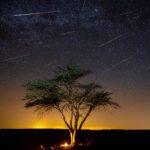A world-class telescope in outback Western Australia is on the verge of unlocking more secrets from the start of the Universe as new technology upgrades are rolled out during its historic 10-year anniversary.
The Murchison Widefield Array (MWA) project, a powerful telescope made up of 8,192 antennas spread across more than 30sqkm on Wajarri Yamaji land, about 300km north-east of Geraldton, is celebrating a decade of operations this week.
To mark the significant occasion, the global astronomy community – including a consortium of Swiss universities representing the latest organisations to join the international project – has gathered in Perth for the milestone.
Curtin University Vice-Chancellor Professor Harlene Hayne said the MWA project was making new discoveries about the Universe while upskilling our workforce, training future leaders through PhD research, stimulating advanced industries and delivering national economic benefits.
“Not only is the MWA telling us more than we’ve ever known about the first stars and galaxies formed more than 13 billion years ago, but it’s also an international success story that demonstrates what can be achieved when the world’s best collaborate across science, engineering, computing and education,” Professor Hayne said.
“In hard numbers alone, Ernst and Young has modelled the significant economic benefit the MWA has brought to the nation, determining that the $34.8 million Australia has invested in the project to date has driven an $81.1 million uplift to our Gross Domestic Product, equating to more than $2 for every $1 spent.”
MWA Director John Curtin Distinguished Professor Steven Tingay said the project was reaching a crucial point in its operations.
“In the next 12 months, a major upgrade to the MWA’s facilities in WA will enable it to generate four times more data than it ever has while doubling its sensitivity to probe even deeper into the secrets of our Universe,” Professor Tingay said.
“The project is also reaching its critical final phase as we approach the 2029 completion of the Square Kilometre Array (SKA) Observatory, a global collaboration that will build and operate the world’s largest and most sensitive telescope, tasked with answering some of astronomy’s biggest questions.”
Over the past decade of the MWA’s history, it has catalogued and surveyed hundreds of thousands of galaxies, detecting the largest-known eruption in the Universe since the Big Bang, discovering new types of exotic celestial objects that generate periodic bursts of radio waves – and even uncovering new structures in the Earth’s uppermost atmosphere.
It has also discovered a mysterious object in our Galaxy – possibly a dead star with an intense magnetic field that produces powerful bursts of radio waves every 18 minutes, determined new limits on the Epoch of Reionisation, the period when the first stars and galaxies formed, and produced an all-sky survey that resulted in the first radio-colour panorama of the Galaxy.
A consortium of Swiss universities led by École Polytechnique Fédérale de Lausanne (EPFL), which is joining the Curtin-led MWA collaboration for the final phase, is being represented at this week’s celebrations.
The Swiss consortium will be joining an international collaboration of universities and research organisations from Australia, the United States of America, Canada, China and Japan to support the expansion of the telescope.
The MWA is the longest-running precursor instrument to the SKA, which is being constructed on the same site.
The Federal Government has supported the operations of the MWA.
Western Australia has provided defining support for the SKA project for more than 20 years, with the State Government, Curtin University and The University of Western Australia funding the International Centre for Radio Astronomy Research (ICRAR) since 2009.
For more information about the MWA, visit here.


